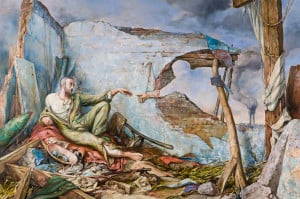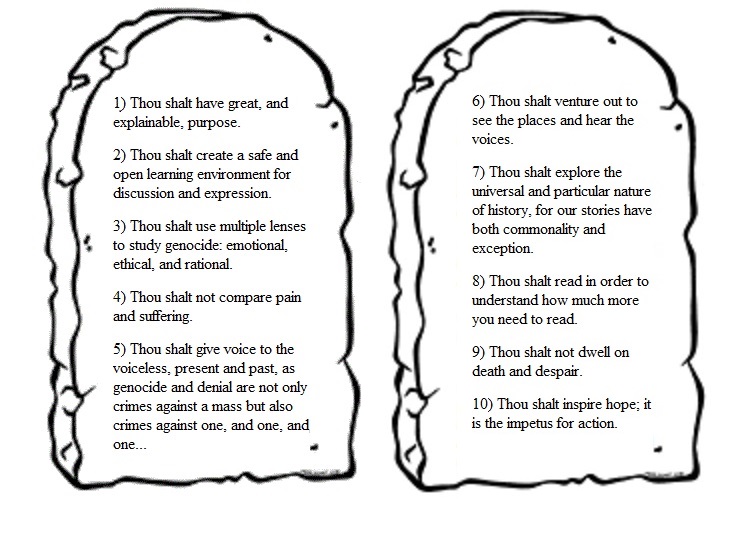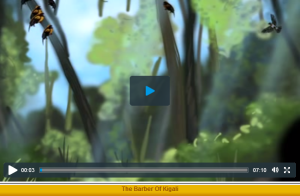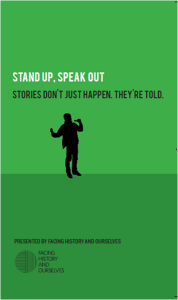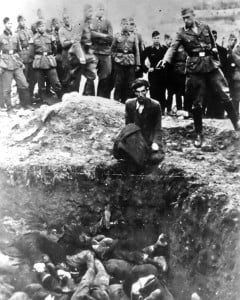One of my most powerful childhood memories is seeing "The Ten Commandments" in the original "Cinemascope" at the now demolished Glendale Cinema on Avenue Road. I never forgot the grandeur of the huge screen especially in scene where Moses (Charlton Heston) epically raised his arms with the Rod of God aloft, and the sea crashed down upon the pursuing Egyptians while Pharaoh (Yul Brynner) gasped in awe and said: "The Lord is God." So much for nostalgia. I wonder what Moses would have said watching a synagogues of Germany burn down on Kristallnacht when firefighters stood idle and crowds gathered to gawk? He might well have asked, as do my students, "where was God"?
Where was God during the Shoah? Jewish students seek answers in Art and Tradition
Posted by Jack Lipinsky on April 21, 2013
Topics: History, Holocaust Education, Lesson Ideas
Avoiding Victimhood: enticing our students to think critically about Genocide
Posted by Jack Lipinsky on April 21, 2013
My last couple of posts have focused on the educational methodology of teaching media savvy students how to examine visual evidence of the Shoah. I have recorded some of our class conversations and you must wonder: what is the atmosphere like in this classroom? Is it terribly negative considering what is being learned? Mustn't it be especially upsetting for students in a Jewish day school to learn the horrific details of the Shoah, the Holocaust, that wiped out an entire Eastern European civilization? My students find this study enlightening and are not depressed but eager to learn more and empowered by what they discover. I would like to share how this can be done. For me, this is an issue that transcends ethnicity, nationality, or religion. How are students affected by learning about genocidal attempts that strike 'close to home"? Let me begin with a story that exemplifies what Facing History is all about.
Topics: Professional Development, Genocide and Crimes Against Humanities Course
7 Great Little Viral Videos for the Facing History Classroom
Posted by Michael Grover on April 13, 2013
The Facing History resource “Pigeon” demonstrates the impact a short film can have. Set amid the tension of occupied Europe during World War II, it is an example of the power an individual has to make a difference, if they choose to do so. A viral video is a video that results from online distribution and sharing, an excellent route to engaging our students. Finding short videos online is, therefore, a powerful teaching strategy.
Video clips are accessible to many learning styles, and of particular value when teaching the applied and essential level student. As ‘clips’, they are brief, thus benefiting shorter attention spans and working well in the structure of the 3-part lesson for the 75 minute classroom. They are easily shared if a student is absent (unlike a film) and easily re-watched (either individually or collectively) without generating a great burden on classroom time, which is so precious. And they play to the sensibilities of the digital generation (which in turn allows us as teachers to create the pretense to a shared sense thereof).
Topics: Facing History Resources, videos, Strategies, Lesson Ideas
One of the challenges many teachers experience is trying to meet the needs of their diverse student population in their respective classes. Differentiated instructions strategies (D.I.) enables teachers to better meet these varied needs and in turn enables students to be successful because their needs are met at their level of readiness, interests and learning styles.
Topics: History, Middle School, Strategies, Lesson Ideas, English Classroom, Literature
Collaborative Inquiry using NIGHT: An Interview with Professor Rob Simon
Posted by Jasmine Wong on April 8, 2013
In this interview, we asked Rob Simon, Assistant Professor of Multiliteracies in Education at OISE/University of Toronto (Dept of Curriculum, Teaching and Learning), to tell us more about the Teaching to Learn Project so we could better understand how and why collaborative (teacher-adolescent) curriculum planning worked, why he chose Elie Wiesel's Night as the study text, and where he got the idea to ask project participants to paint on the pages of the text as a form of reading response.
The images below are the culmination of those responses, which were mounted in an exhibition titled After Night.
Topics: Facing History Resources, Innovative Classrooms, Holocaust Education, Lesson Ideas, English Classroom
As my students build their journals, ideas of injustice and intolerance flood their pages. Yet this month, the pens are down and students of Genocide are standing up and speaking out. Mathew Jones A.K.A “TESTAMENT” provided Waterdown students with the tools and the inspiration to put their thoughts into Spoken Word Art.
Topics: Art, Events, Innovative Classrooms, Memorial, Genocide and Crimes Against Humanities Course, Personal history
I recently completed a Guidance AQ with a heavy focus on counselling methodologies. In one session we previewed Solution Focused Counselling and in another Bereavement Counselling was the focus. Whereas Solution Focused Counselling relies heavily on the Active Coping Strategy concentrating on Problem Focused Coping including Cognitive Decision Making and Direct Problem Solving and Bereavement Counselling focused on Support Seeking Coping Strategies such as Support for feelings (CCSC & HICuP, 7), in both the importance of teaching coping strategies was highly emphasized. It became clear to me that the need to teach our students effective coping strategies is important (for further on this, see “Eight Important Reasons for Teaching Kids Healthy, Brain-based Coping Skills in School”).
Topics: Professional Development, Strategies
"The Last Jew in Vinnitsa": How Media provides a way to understand Perpetrators/Bystanders/Victims
Posted by Jack Lipinsky on April 7, 2013
Graphic imagery is used in this lesson. Please read the full post before teaching this.
I start by displaying the famous photo called "The Last Jew in Vinnitsa."
I say, "This was the title given by the Einsatzgrup soldier in whose pocket it was found, scribbled on the back. Vinnitsa is a small town in the Ukraine whose entire Jewish population was wiped out by the Einsatzgruppen mass killing methods in 1941."
This is all I tell my students when displaying this picture. They have already learned about the Einsatzgruppen and read the selection on "Battalion 101" in Holocaust and Human Behaviour Chapter 7 Reading 3 . They have also been taught that there are three groups involved in genocide: perpetrators, bystanders, and victims.
Topics: History, The Last Jew in Vinnitsa, genocide, Genocide and Crimes Against Humanities Course, Lesson Ideas, reflection
Using Visual Media to Learn about Genocide--OR--Goodbye "boring" History classes
Posted by Jack Lipinsky on April 7, 2013
In my last post I noted how saturated our students are by visual media. What a sharp contrast their lives are with mine at their age. In my high school history classes, the walls were adorned with old men, mostly with mutton chop whiskers and beards, staring down at me. Each of them had their name, dates of birth and death, and a sour stare that intimidated me when I glanced at them. My teachers reverently cited these old mens' careers and quoted them to the point of endless boredom.
Topics: History, Middle School, Strategies, Genocide and Crimes Against Humanities Course, Lesson Ideas

